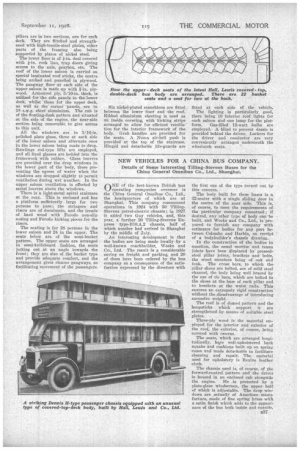NEW VEHICLES FOR A CHINA BUS COMPANY.
Page 21

Page 22

If you've noticed an error in this article please click here to report it so we can fix it.
Details of Some Interesting Tilling-Stevens Buses for the China General Omnibus Co., Ltd., Shanghai.
ONE of the best-known British bus operating companies overseas is the China General Omnibus Co., Ltd., the headquarters of which are at Shanghai. This company commenced operations in 1924 with 50 TillingStevens petrol-electric chassis; in 1927 it added two Guy vehicles, and, this year, a further 20 Tilling-Stevens Express type-B10.A.2 chassis, half of which number had arrived in Shanghai by the middle of July.
An interesting development is that the bodies are being made locally by a well-known coachtmilder, Vtreeks and Co., Ltd. The result is a considerable saving on freight and packing, and 20 of them have been ordered by the bus company as a consequence of the satisfaction expressed by the directors with the first one of the type turned out by this concern.
The body built for these buses is a 32-seater with a single sliding door in the centre of the near side. This is, of course, to meet the requirements of the particular company concerned; if desired, any other type of body can-he built, and Weeks and Co., Ltd., is prepared to furnish any company with estimates for bodies for any port between Colombo and Harbin, on receipt of a bodybuilder's chassis drawing.
in the construction of the bodies in question, the usual mortise and tenon joints have been displaced by pressedsteel pillar joints, brackets and bolts, the wood members being of oak and teak. The cross bars, to which the pillar shoes are bolted, are of mild steel channel, the body being well braced by the use of tie bars, which are bolted to the shoes at the base of each pillar and to brackets at the waist rails. This ensures an extremely rigid construction without the .disadvantage of introducing excessive weight.
The roof is of domed pattern and the hoopsticks which support it are strengthened by means of suitable steel plates.
Three-ply wood is the material employed for the interior and exterior of the roof, the exterior, of course, being covered with canvas.
The seats, which are arranged longitudinally, live well-upholstered back squabs and cushions built up on spring cases and made detachable to facilitate cleaning and repair. The material used for upholstery is Rexine leather cloth: The chassis used is, of course, of the forward-control pattern and the driver is housed in an enclosed cab alongside the engine. He is protected by a plate-glass windscreen, the upper half of which is adjustable. The drop windows are _actually of American maimfacture, made of fine spring brass with a satin finish which adds to the appearance of the bus both inside and outside. Drop windows are also provided at the front and rear of the body. Further to assist ventilation, particularly when these windows have to be shut owing to inclement weather, four Airvac ventila tors are arranged down the centre of the roof. Incidentally, there are five electric lamps at each side, together with the usual straps for standing passengers.
Five of these buses have already been put into service by the company and these will be followed by the remaining 15 so soon as the chassis arrive and the bodies can be fitted.
These vehicles run on pneumatic tyres and, consequently, should be extremely comfortable. The tyres used are of Dunlop makes, the size being 118ins, by 7-ins., twins being employed at the rear.
Inside the vehicle the roof is 6 ft. 6 ins. above the floor, allowing ample freedom of movement even for the tallest passenger.






























